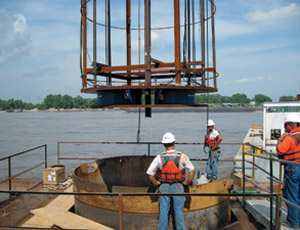Firms working on the $670-million Mississippi River Bridge in St. Louis have shattered geotechnical records related to one of the bridge’s drilled-shaft concrete foundations while verifying a time-saving, alternate pier plan.

The test, performed this past June, consisted of drilling an 11.5-ft-dia shaft 43.5 ft under the riverbed, then cutting an 11-ft-dia socket more than 23 ft into the underlying limestone bedrock. An Osterberg load cell then was lowered to the bottom of the rock socket, and reinforced concrete was poured into the hole.
When the concrete had hardened, hydraulic pumps raised the pressure to the designated 36,067-ton level. The socket and pier passed the test, performed by Geotechnology Inc. under the watch of prime contractor MTA Joint Venture, both of St. Louis, geotechnical engineer Dan Brown & Associates, Sequatchie, Tenn., and testing equipment provider Loadtest Inc., Gainesville, Fla.
The confirmed 18,000 tons of end-bearing force and 18,000 tons of side-bearing force are the highest total load ever for any foundation test, say geotechnical engineers. “There may have been higher per-square-foot pressures, but for total load, this … is the highest ever,” says Dan Brown, geotechnical engineer.
The test verified that using six 11.5-ft-dia piers—instead of the proposed 14 10-ft-dia piers—in each foundation will provide ample support and cut in half pier construction time. The bridge, scheduled to open in January 2014, will be the country’s third-longest cable-stayed bridge, with a main span of 1,500 ft.

Post a comment to this article
Report Abusive Comment